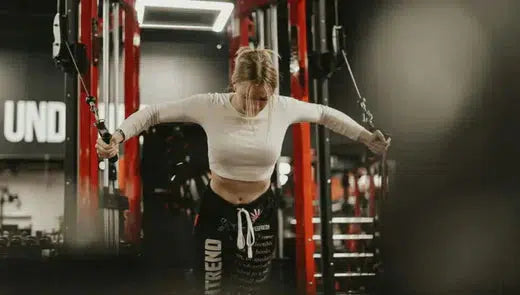
How to Do a Cable Fly
Share
The cable chest fly is a great exercise for building chest strength and definition. It’s a joint-friendly alternative to bench press or dumbbell flyes, with consistent muscle engagement throughout the movement. This will show you how to do the cable chest fly so you get the most out of your workout.
Table of Contents
Why Cable Fly?
Cable flyes are good for isolating the chest muscles, with tension throughout the entire movement. Unlike free weights, functional trainers or cable machine provide constant resistance, leading to better muscle activation and growth potential. They’re also kinder to the shoulders, so they’re good for people with joint issues. Plus, it promotes good form by engaging the core and stabilizing the shoulder blades.

How to Do a Cable Fly: Step by Step
-
Set Up the Machine
- Adjust the cable machine pulleys to chest height.
- Attach single-handle grips to each pulley.
- Stand between the two stacks and grab the handles.
-
Get into Position
- Face away from the cable machine and step forward into a staggered stance (one foot in front of the other).
- Hinge forward at the hips, keep your back straight and core engaged.
- Extend your arms out in front of your chest, palms together.
-
Do the Movement
- Slowly let the handles move out in an arc, keeping a slight bend in your elbows. Stop when your hands are at chest height.
- Squeeze your chest muscles to bring the handles back together in front of your chest, following the same arc.
- Repeat for the desired number of reps.
Tips:
- Don’t lock your elbows to keep tension on your chest muscles.
- Control the movement, especially the lowering phase, to get maximum muscle activation.
- Focus on form and control rather than weight.
- Keep your shoulder blades stable throughout the movement.
Cable Chest Fly Variations
High Cable Flyes
- Setup: Adjust the pulleys to shoulder height.
- Execution: Start with your arms out to the sides at shoulder height; bring the handles together in front of you in a wide arc, keeping a slight bend in your elbows.
- Target: Upper chest and shoulders.
Low-to-High Cable Flyes
- Setup: Set the pulleys to the bottom position.
- Execution: Start with the handles at hip height and bring them up in an arc to meet in front of your chest.
- Target: Upper chest.

Standing Cable Flyes
- Starting position: Position the pulleys at chest height, grab the cable handles.
- Execution: Do the fly while standing, keeping your arms extended throughout the movement.
- Target: Engages the entire chest and requires core stability.
Benefits of Cable Chest Fly
- Joint Friendly: Reduces stress on the shoulder joint compared to other chest exercises, and may alleviate shoulder pain.
- Continuous Tension: Engages the muscle throughout the entire movement.
- Muscle Isolation: Allows targeting specific areas of the chest depending on the pulley height.
- Aesthetics: Good for shaping and defining the chest muscles.
FAQ Cable Chest Fly
What muscles does cable chest fly work?
Cable chest fly works the pectoralis major, with secondary engagement of pectoralis minor, deltoids, triceps, and core.
Is cable chest fly for beginners?
Yes! The Cable chest fly is beginner-friendly and will improve chest strength and definition when done with the correct form.
How often should I do cable chest fly?
Do cable chest fly in your chest or upper body workout 1-2 times a week depending on your training schedule.
What’s the difference between cable fly and dumbbell fly?
Cable chest fly provides continuous tension throughout the movement, while dumbell fly provides variable resistance with less tension at certain points.
Add cable chest fly to your workout and boost your chest development. Whether you’re a beginner or an experienced lifter, mastering this exercise will give you a stronger and more defined chest. Get the best training experience with SuperStrong Fitness equipment and premium gym flooring. Check out our blog for a comprehensive range of full body exercises or trending articles.
By Michael Geraghty
Related blogs:
